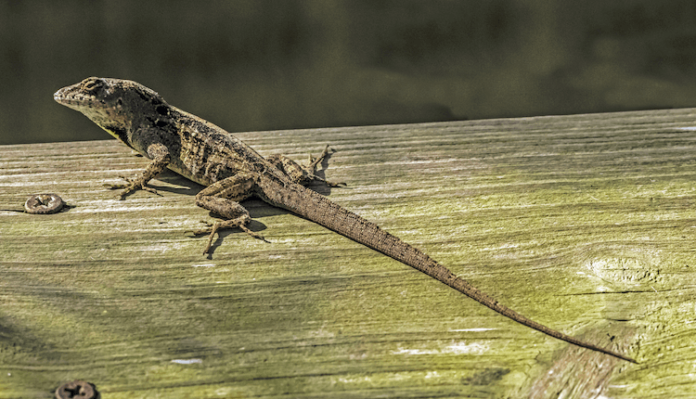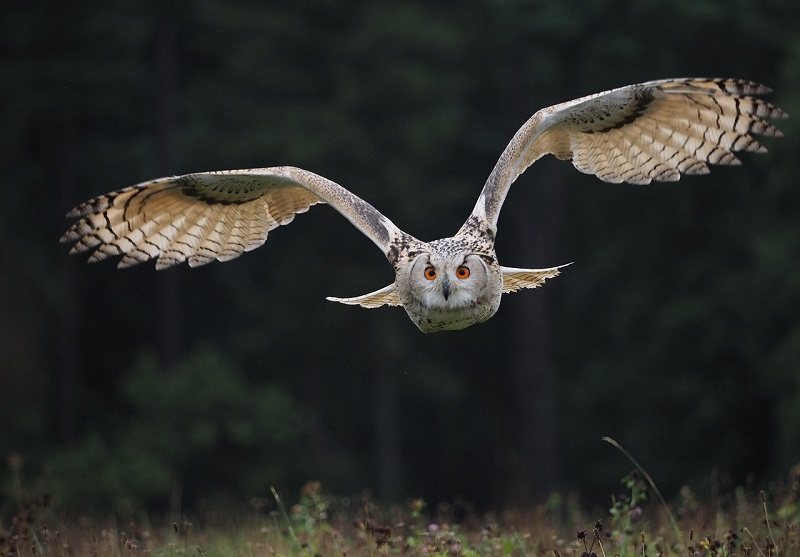Last Updated on January 18, 2024 by Fumipets
Lizard Species Found in Florida
If you’ve traveled to Florida, you’ve undoubtedly seen a lizard. Lizards are probably a familiar sight for you if you reside there! These pals seem to be almost everywhere and have the ability to enter your house or vehicle. Only 15 of the more than 50 lizard species that call the Sunshine State home are indigenous. Every lizard has a function in the ecology. They are prey for snakes and other bigger animals while preying on pests like insects and rodents. Let’s examine the typical native and exotic lizard species found in Florida.
10 Types of Lizards Found in Florida:
Small Lizards
These small native Florida pals are lizards. Here is a list to assist you identify them since some may be more difficult to detect than others.
1. Green Anole
| Species: | Anolis carolinensis |
| Longevity: | 2 – 8 years |
| Good to own as a pet?: | Yes |
| Legal to own?: | Yes |
| Adult size: | 5 – 8 inches |
| Diet: | Crickets, worms, spiders, moths, and beetles |
In Florida, it’s usual to see Green Anoles. Due to their ability to change color, they are often mistaken for chameleons. Although their bodies are typically green, they have the ability to become brown, gray, or yellow. Their sticky feet aid in their ascent. When a male Green Anole is prepared to engage in combat or attempt to entice a mate, the dewlap, or little pink flap of skin, on their necks becomes crimson. These lizards are almost everywhere. In the warmer months, they like relaxing in yards and gardens and soaking up the sun.

2. Six-Lined Racerunner
| Species: | Cnemidophorus sexlineatus |
| Longevity: | 6 years |
| Good to own as a pet?: | Yes |
| Legal to own?: | Yes |
| Adult size: | 6 – 9. 5 inches |
| Diet: | Grasshoppers, crickets, and other insects |
Six-Lined Racerunners are almost always hanging out on the ground. They may be found in open, hot, and dry places like fields and dunes. They like being hot. They move swiftly and often pounce on their victim after stalking it. The six yellow lines that run the length of this lizard’s body from head to tail may be used to identify it. The lizard’s body length is divided in half by its tail, which may sometimes reach twice as long. Their bellies are white or light pink females, while their bodies are either dark green or black. Males have light blue bellies and green throats. These lizards have a velvety aspect to their skin rather than a scaly, glossy appearance.

3. Florida Scrub Lizard
| Species: | Sceloporus woodi |
| Longevity: | 1. 5 – 2. 5 years |
| Good to own as a pet?: | No |
| Legal to own?: | Yes |
| Adult size: | 5. 5 inches |
| Diet: | Ants, spiders, and other small anthropods |
The Florida Scrub Lizard is unique to Florida and is a native species there. Their tails are around 5. 5 inches long, making about 3 inches of their whole length. Rough scales cover their brown or gray bodies, and a dark brown stripe runs down their sides from the neck to the tail. On the sides of their bodies and on their necks, males have brilliant blue spots, whereas females either have faint or no blue patches at all. These lizards may be found in sandy, sunny places with trees for cover. Their preferred environment is scrub. The Ocala National Forest’s Sand Pine scrubs are where the majority of these lizards live.

4. Eastern Fence Lizard
| Species: | Sceloporus undulatus |
| Longevity: | 1 – 5 years |
| Good to own as a pet?: | Yes |
| Legal to own?: | Yes |
| Adult size: | 4 – 7. 5 inches |
| Diet: | Crickets, grasshoppers, and fruit flies |
In Northern Florida and parts of the Southeastern United States, this lizard may be found on tree trunks and fence posts. They spend the day tanning in the sun. They hunker down at night, finding shelter among rocks, logs, and stumps. To better fit in with their environment, their bodies are either black or brown in color. They cling to tree bark, making it difficult to see them. On their backs, females have black horizontal stripes that help identify them. On the undersides of the males, there are blue spots.

5. Reef Gecko
| Species: | Sphaerodactylus notatus |
| Longevity: | 10 – 20 years |
| Good to own as a pet?: | Yes |
| Legal to own?: | Yes |
| Adult size: | 2 – 2. 5 inches |
| Diet: | Beetles, ants, and insect larvae |
The Reef Gecko is the smallest lizard found in North America. Hatchlings are 1 inch in length at birth, but adults grow to be around 2 inches long. Because they tend to hide behind objects like leaves and foliage to forage for insects, they may be difficult to see. At nightfall, they come to life. They have light brown scales, and their bodies are covered with dark brown dots all over. Three broad, black stripes on the females’ heads serve as a distinguishing feature. The Reef Gecko is eaten by lizards, birds, and snakes. They can better blend into their environment thanks to their pigmentation and avoid predators.

Big and Invasive Lizards
The lizards that follow are not only big, but they are not endemic to Florida. It’s important to watch out for these large, invasive species since some of them may be dangerous to humans.
6. Brown Anole
| Species: | Anolis sagrei |
| Longevity: | 1. 5 – 5 years |
| Good to own as a pet?: | No |
| Legal to own?: | Yes |
| Adult size: | 9 inches |
| Diet: | Insects, other lizards, lizard eggs, and their own detached tails |
These lizards will consume both their own hatchlings and the hatchlings of the Green Anole in addition to their own shed skin and detachable tails. A decline in the Green Anole population has occurred after this invasive species made its way from Cuba to Florida. Compared to other Anoles, brown Anoles have larger heads and shorter noses. They can climb glass because of their lengthy toes, which also allow them to connect to any surface. They have light brown bodies with light tan lines and black and white patterns on their backs. The Brown Anoles have reddish-orange dewlaps, much as the Green Anoles do. They like dampness and are active throughout the day. Although they may survive in any habitat, these lizards like areas with ground cover and sunbathing areas.

7. Green Iguana
| Species: | Iguana iguana |
| Longevity: | 12 – 15 years |
| Good to own as a pet?: | No |
| Legal to own?: | Yes |
| Adult size: | 12 – 60 inches |
| Diet: | Leaves, plants, fruit, and flowers |
In Florida, this lizard is regarded as an invasive species. The tropical jungles of Central and South America are home to the Green Iguana. They are regarded as nuisance animals in Florida because they ruin crops and plants. Additionally, they harm property by excavating burrows that may bring down foundations and sidewalks. Despite having the name “Green,” these enormous monsters may also be blue, purple, brown, red, black, and orange in color. If they are seized by predators, they may remove their lengthy tails from their bodies, enabling the lizard to escape to safety and subsequently grow a new tail. The sharp dewlaps of green iguanas control their body temperature. Green Iguanas may be seen in trees during warm weather. They are adept climbers, and when they do fall, they often do so unharmed. They may puncture human flesh with their bites due to their strong teeth.

8. Argentine Black and White Tegu
| Species: | Salvator merianae |
| Longevity: | 15 – 20 years |
| Good to own as a pet?: | No |
| Legal to own?: | Yes |
| Adult size: | 60 inches |
| Diet: | Insects, snails, rodents, fruits, and eggs |
These invasive lizards destroy habitat and endanger Florida’s wildlife by consuming their prey’s eggs. They are enormous and resemble alligators, but their backs and tails are banded in black and white. They are adept swimmers and are often found near bodies of water. Although Argentine Black and White Tegus usually do not attack people, they may bite if they feel threatened. They have powerful jaws and bite with a terrible, destructive force. Fortunately, there are warning indications that you should leave the Tegu alone and move away from them, like hard breathing, tail thrashing, and foot stomping. If these warnings are ignored, they have been known to charge and bite.

9. Tokay Gecko
| Species: | Gekko gecko |
| Longevity: | 10 years |
| Good to own as a pet?: | No |
| Legal to own?: | Yes |
| Adult size: | 13 –16 inches |
| Diet: | Small rodents, moths, crickets, cockroaches, and mosquitos |
The Tokay Gecko is a large species of gecko that originated in South Asia. To escape being caught by a predator, these invading lizards may separate their tails. The assailant will be confused by the thrashing tails while the gecko may flee. Tokay geckos come in two varieties: red-spotted and black-spotted. These markings adorn a muscular, blue-gray body.
They may live in the walls of houses in addition to the rocky or tropical habitats where they are normally found in Florida. Because these lizards may act as natural pest management, most people don’t mind. They may extract blood with a single bite and move quite quickly. The Tokay Gecko will seize hold and refuse to release. They will just tighten their hold if you attempt to get them to release it. Through their saliva in a bite wound, they may transmit germs to people, including salmonella.

10. Nile Monitor
| Species: | Varanus niloticus |
| Longevity: | 20 years |
| Good to own as a pet?: | No |
| Legal to own?: | Yes |
| Adult size: | 70 – 80 inches |
| Diet: | Crabs, frogs, turtles, birds, and small mammals |
In Florida, you may locate this invasive lizard around bodies of water. Nile Monitors have long, thick bodies and are either olive green or black. They have bands and dots along the length of their backs and cream or yellow stripes on their heads and jaws. They are adept swimmers and have a 15-minute underwater survival time. On rocks and trees, they enjoy the sunshine close to the sea.
Although this lizard has venom, it seldom kills people. The toxin is harmful to tiny animals and will kill their prey. If you come across one of these lizards, leave it alone and move back from the area since they won’t attack a person unless they feel threatened. In captivity, Nile Monitors are hostile and do not wish to be domesticated. People seeking to keep these lizards as pets are to blame for the majority of bite wounds to humans.

Conclusion
In Florida, there are several lizard species, however the majority are not dangerous. These lizards range in size from very little to quite big, and they may be found across the state in varied habitats. Although no lizards in Florida are dangerous to people, some of them might be considered a nuisance. Several lizards, including the Argentine Black and White Tegu, Tokay Gecko, Green Iguana, and the Nile Monitor, have been known to bite humans inflicting painful and sometimes bacterial bites. If you come across a lizard, this list may help you decide which ones are safe to handle and which ones you should stay away from.


















